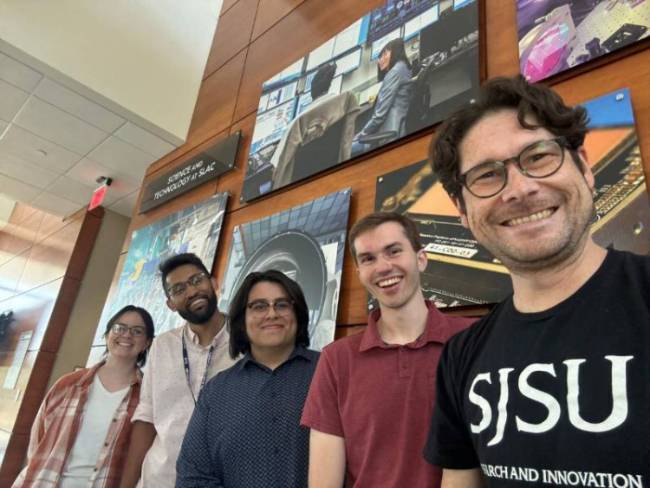News 2025
NSBP/NSHP 2025
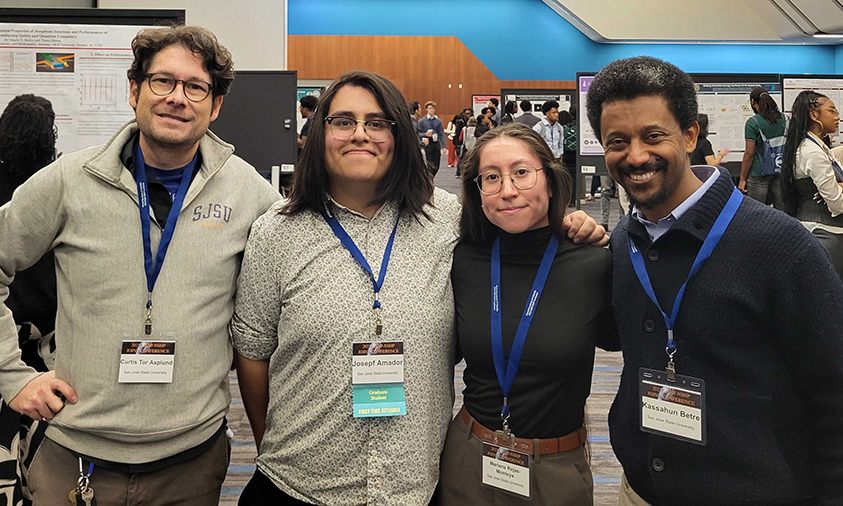
November 23rd -- The National Society of Black Physicists (NSBP) and National Society of Hispanic Physicists (NSHP) held their annual meeting this year as a joint conference here in San Jose, and SJSU students and faculty members alike made a strong showing! Featured speakers and attendees included Assistant Professors Curtis Asplund and Kassahun Betre, and master's students Josepf Amador and Mariana Rojas-Montoya.
Examining Exams
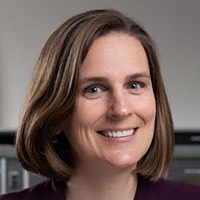 October 21st -- Professor Cassandra Paul has a new paper out, published in Physical Review Physics Education Research, which reveals a surprising set of findings connected to the equity impact of in-class
exams as utilized in physics classes. The study, conducted in collaboration with David
Webb at UC Davis, is entitled "High-stakes exams inflate a gender gap and contribute
to systematic grading errors in one introductory physics series," and in it Paul and
Webb report on a persistent gender gap that appears in exam grades, which has been
widely reported in introductory physics courses. Amazingly, this gap is totally eliminated
when instructors employ retake exams because women do better on the first try (which
is to say that a re-take isn't even necessary to remove the gender gap; all that is
required is for the possibility of a re-take to exist). The study adds to an increasing
body of evidence that exam stakes (and not differences in physics preparation or understanding)
explain the gender gap in introductory physics. The manuscript suggests that instructors
interested in removing the impact of stakes as a bias against women in their physics
courses would do well to consider employing retake exams and/or other low stake assessments.
October 21st -- Professor Cassandra Paul has a new paper out, published in Physical Review Physics Education Research, which reveals a surprising set of findings connected to the equity impact of in-class
exams as utilized in physics classes. The study, conducted in collaboration with David
Webb at UC Davis, is entitled "High-stakes exams inflate a gender gap and contribute
to systematic grading errors in one introductory physics series," and in it Paul and
Webb report on a persistent gender gap that appears in exam grades, which has been
widely reported in introductory physics courses. Amazingly, this gap is totally eliminated
when instructors employ retake exams because women do better on the first try (which
is to say that a re-take isn't even necessary to remove the gender gap; all that is
required is for the possibility of a re-take to exist). The study adds to an increasing
body of evidence that exam stakes (and not differences in physics preparation or understanding)
explain the gender gap in introductory physics. The manuscript suggests that instructors
interested in removing the impact of stakes as a bias against women in their physics
courses would do well to consider employing retake exams and/or other low stake assessments.
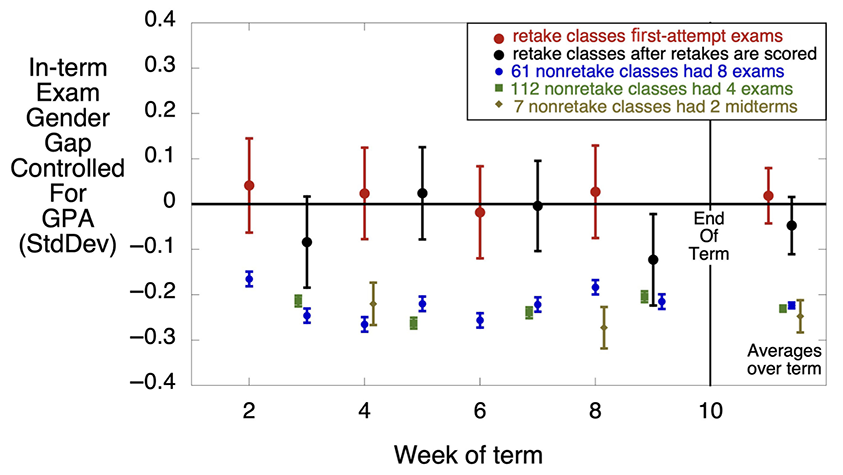
APS Far West Section Meeting
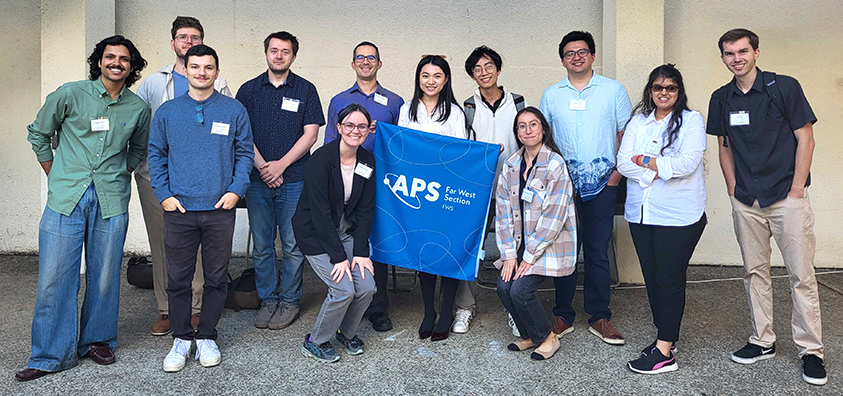
October 13th -- SJSU students and faculty members made a trek out to UC Santa Cruz this past weekend for the American Physical Society (APS) Far West Section Meeting, presenting posters and establishing new connections to the broader regional community of physicists. Poster presentations and oral talks abounded, covering subjects ranging from magnetism in exotic crystal lattices to the possibility of seeing dark matter in free dwarf galaxies to the potential for using laser pointers in interferometric devices. Very nice work!
Cal-Bridge Scholars and Mentors attend the Fall Conference
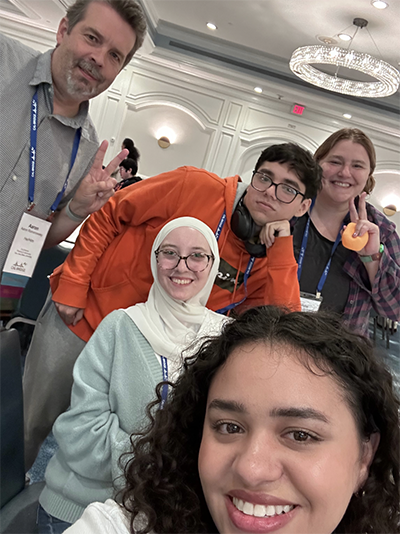 October 8th -- This past weekend, the Cal-Bridge Program held their annual Fall Conference
at UC Irvine! SJSU Physics & Astronomy Cal-Bridge scholars and mentors attended together,
an opportunity to be in community with the larger Cal-Bridge network. Special shout-out
to team "San José State (Unofficial)," who came in 2nd Place in the trivia contest,
winning squishy toys and other delights, and barely missing first place by one point.
A selection of some of the correct answers included "Martha Washington," "Ottawa,"
"Praying Mantis Shrimp," and "Slipknot."
October 8th -- This past weekend, the Cal-Bridge Program held their annual Fall Conference
at UC Irvine! SJSU Physics & Astronomy Cal-Bridge scholars and mentors attended together,
an opportunity to be in community with the larger Cal-Bridge network. Special shout-out
to team "San José State (Unofficial)," who came in 2nd Place in the trivia contest,
winning squishy toys and other delights, and barely missing first place by one point.
A selection of some of the correct answers included "Martha Washington," "Ottawa,"
"Praying Mantis Shrimp," and "Slipknot."
Dynamics of Non-Equilibrium Variables Workshop
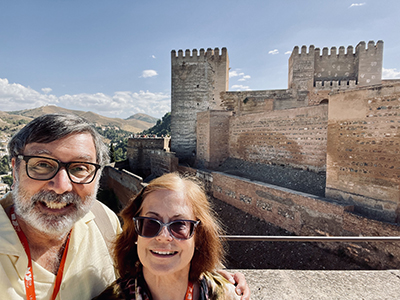 September 29th -- Emeritus Professor Alejandro Garcia gave an invited tutorial lecture
this past month on fluctuating hydrodynamics at the Dynamics of Non-Equilibrium Variables workshop in Zaragoza, Spain. He and his wife, Cecile Penland, also gave research talks on
turbulence and on climate prediction. During this trip they had the opportunity to
visit the Andalucian cities of Seville, Cordoba, and Granada.
September 29th -- Emeritus Professor Alejandro Garcia gave an invited tutorial lecture
this past month on fluctuating hydrodynamics at the Dynamics of Non-Equilibrium Variables workshop in Zaragoza, Spain. He and his wife, Cecile Penland, also gave research talks on
turbulence and on climate prediction. During this trip they had the opportunity to
visit the Andalucian cities of Seville, Cordoba, and Granada.
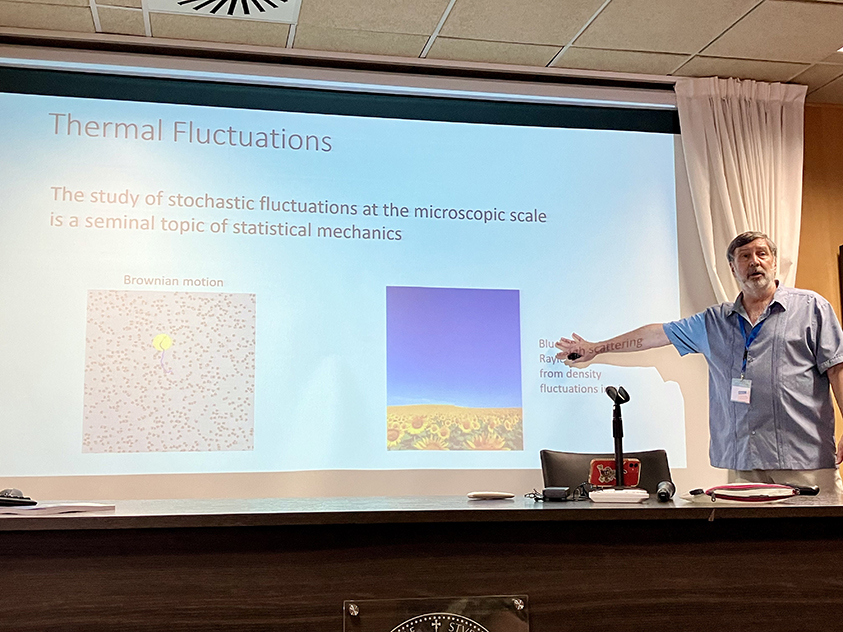
Astronomy 11 Laboratory Kicks Off
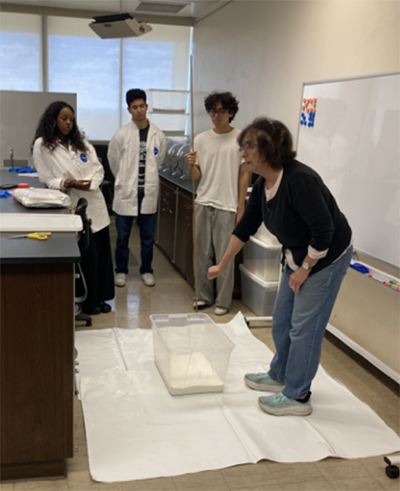 September 15th -- Lecturer Olenka Hubicjky, with help from Professors Aaron Romanowsky
and Thomas Madura, as well as the notes left behind by Les Tomley, has created a new
astronomy laboratory class that is being taught for the first time this semester.
The course, entitled ASTR 11L (Introductory Astronomy Lab) is a General Education
(GE) class that offers "interactive engagement with the wonders of the cosmos." Topics
include awareness of the sky (what can be seen and where), its motions, and perspectives
from diverse cultures over time. Students will also be learning how to use telescopes
and other astronomical instruments to measure the characteristics of planets, stars,
galaxies, and the Universe itself. Finally, the class intends to explore the possibility
of extraterrestrial life; are we alone in the universe and if not, then where are
all the aliens? and what might first contact look like? Heady stuff!
September 15th -- Lecturer Olenka Hubicjky, with help from Professors Aaron Romanowsky
and Thomas Madura, as well as the notes left behind by Les Tomley, has created a new
astronomy laboratory class that is being taught for the first time this semester.
The course, entitled ASTR 11L (Introductory Astronomy Lab) is a General Education
(GE) class that offers "interactive engagement with the wonders of the cosmos." Topics
include awareness of the sky (what can be seen and where), its motions, and perspectives
from diverse cultures over time. Students will also be learning how to use telescopes
and other astronomical instruments to measure the characteristics of planets, stars,
galaxies, and the Universe itself. Finally, the class intends to explore the possibility
of extraterrestrial life; are we alone in the universe and if not, then where are
all the aliens? and what might first contact look like? Heady stuff!
Curtis Asplund Quoted in Physics Today
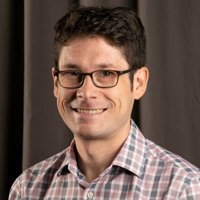 September 9th -- Assistant Professor Curtis Asplund has been quoted in the Physics
Today article Nobel laureates issue declaration for the prevention of nuclear war. Events like this spotlight the growing dangers of nuclear weapons. Importantly,
however, they also highlight that role that physicists can and do play in informing
the public and policy makers about these dangers and calling for following through
on our commitments to nuclear disarmament.
September 9th -- Assistant Professor Curtis Asplund has been quoted in the Physics
Today article Nobel laureates issue declaration for the prevention of nuclear war. Events like this spotlight the growing dangers of nuclear weapons. Importantly,
however, they also highlight that role that physicists can and do play in informing
the public and policy makers about these dangers and calling for following through
on our commitments to nuclear disarmament.
College of Science Award Winners
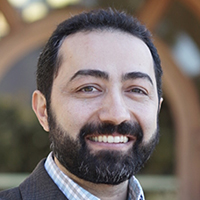
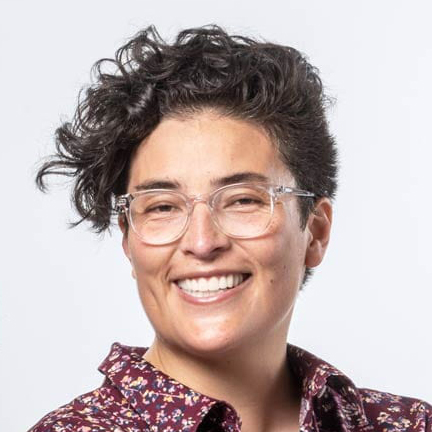
August 19th -- The Department of Physics and Astronomy made a strong showing this fall among the slate of College of Science Award winners. Professor Ehsan Khatami won the Dean's Scholar Award, and Lecturer Annie Chase won the award for Innovation for Student Success. Congratulations!
Physics Education Research in Washington, DC
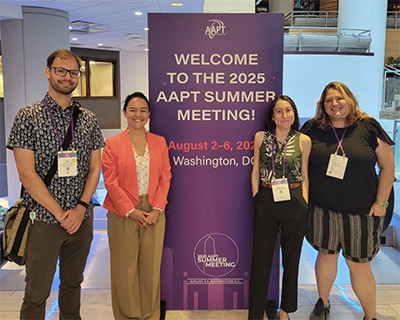 August 6th -- Master’s student Mariana Rojas-Montoya and Assistant Professor Brianne
Gutmann attended and presented at the summer meeting of the American Association of
Physics Teachers, where they ran into other friends of the SJSU Physics department,
Erin Dachille and Camila Monsalve Avendaño, both current graduate students at Michigan
State University. Rojas-Montoya shared her experiences working in the SJSU Transfer
Advocacy Group, and Gutmann shared about her work in the Access Network and facilitated
a workshop for physics teachers about integrating conversations about science and
society into their classrooms.
August 6th -- Master’s student Mariana Rojas-Montoya and Assistant Professor Brianne
Gutmann attended and presented at the summer meeting of the American Association of
Physics Teachers, where they ran into other friends of the SJSU Physics department,
Erin Dachille and Camila Monsalve Avendaño, both current graduate students at Michigan
State University. Rojas-Montoya shared her experiences working in the SJSU Transfer
Advocacy Group, and Gutmann shared about her work in the Access Network and facilitated
a workshop for physics teachers about integrating conversations about science and
society into their classrooms.
SJSU Tech Academy Wraps up Summer Program
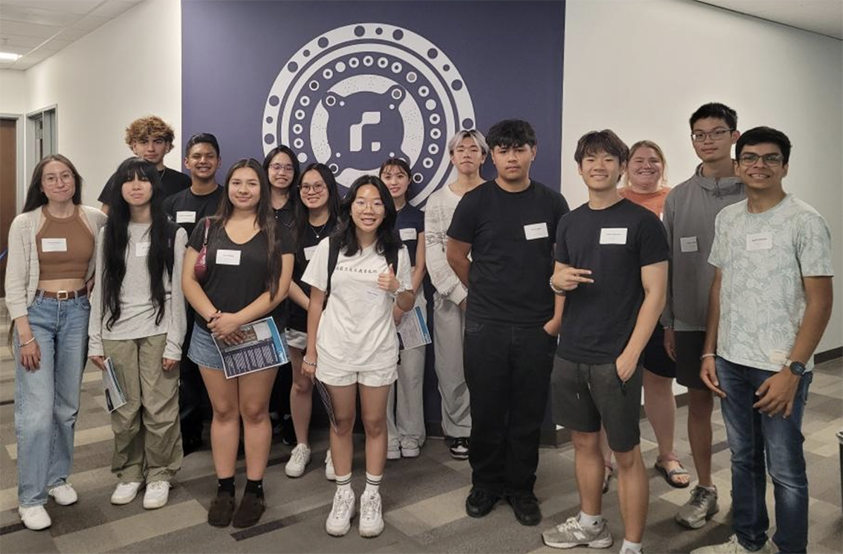
August 2nd -- The SJSU Tech Academy completed its second summer program with S-STEM scholars! Scholars joined the program last summer, when they had just finished their junior year in high school, and this year’s summer program focused on preparing for their first year of college. Students lived in the dorms, got familiar with the campus, learned math, physics, and coding, and went on trips together, including to visit Rigetti Computing (pictured)! The program is run by Assistant Professor Brianne Gutmann and colleagues in Computer Science, Computer Engineering, and Sociology. This summer, Physics Department master’s students Ian Andrews and Mariana Rojas-Montoya also joined the program to support the physics activities.
Excitons in Action
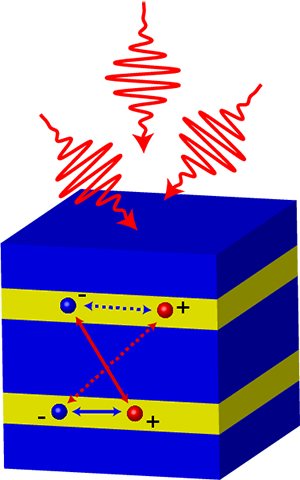 July 18th -- Associate Professor Christopher Smallwood has a new paper out reporting
on the use of pulse lasers to investigate the optical properties of semiconductor
quantum wells. Implications of the work may be relevant to the design of lasers and
LEDs, and to developing a better understanding of how photosynthesis works in nature.
The manuscript appears as an Editors' Suggestion in the journal Physical Review B (see the arXiv for an open-access text), and it features SJSU alumna Smriti Bhalerao (Biomedical Engineering BS, 2022, now
pursuing a PhD in Bioengineering at the University of Maryland) as one of its coauthors.
July 18th -- Associate Professor Christopher Smallwood has a new paper out reporting
on the use of pulse lasers to investigate the optical properties of semiconductor
quantum wells. Implications of the work may be relevant to the design of lasers and
LEDs, and to developing a better understanding of how photosynthesis works in nature.
The manuscript appears as an Editors' Suggestion in the journal Physical Review B (see the arXiv for an open-access text), and it features SJSU alumna Smriti Bhalerao (Biomedical Engineering BS, 2022, now
pursuing a PhD in Bioengineering at the University of Maryland) as one of its coauthors.
The work concerns a special type of excitation that can be made to exist in semiconductor
quantum wells, called an "indirect exciton." To learn more about indirect excitons,
Smallwood and Bhalerao, along with colleagues at the Universities of Michigan, Colorado,
and École Polytechnique Fédérale de Lausanne, interrogated indium gallium arsenide
(InGaAs) double quantum well samples using a technique involving femtosecond pulse
lasers called optical multidimensional coherent spectroscopy (MDCS) and another technique
involving continuous-wave (cw) lasers called photoluminescence excitation (PLE) spectroscopy.
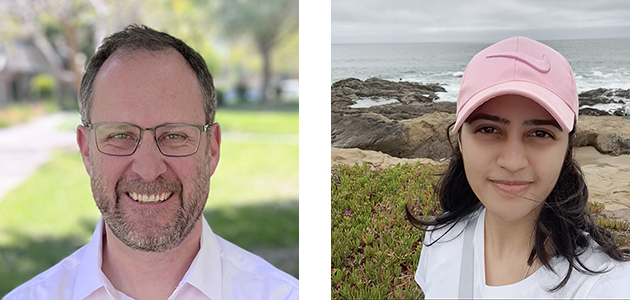
The team discovered signatures of many-body effects in the system that have relevance to exciton dephasing mechanisms and the role of free-electron continuum states. Implications may be of relevance to the physics of manufactured devices including quantum cascade lasers, and to transfer efficiency between energy levels in a variety of naturally occurring quantum-confined systems including photosynthetic light harvesting complexes. The work is entitled "Indirect excitons and many-body interactions in InGaAs double quantum wells," and it was funded in part by NSF Grant #2003493, and an NRC Research Associateship award at NIST.
Geometric Optics Approach to Understanding Spiral Galaxies
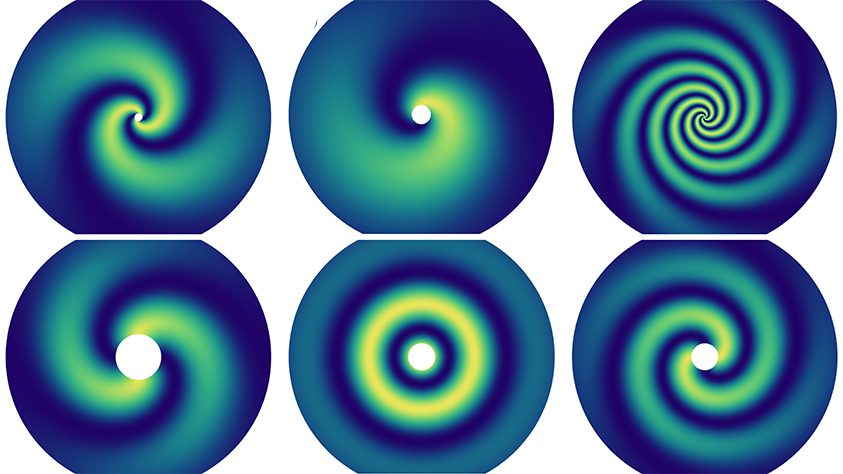
July 9th -- Open University Student Bogdan Szafraniec has a paper out proposing a mechanism for spiral galaxy formation facilitated by the interference of gravitational waves. The manuscript, published in the journal AIP Advances, is entitled "A simple model of spiral galaxies from geometric optics." It was written in collaboration with James Black at Grid Evolution Technologies, and the model proves capable of obtaining outlines of spiral galaxies with arbitrary number of arms and their spiral lengths.
Andre Li Wins a Benzing Fellowship Award
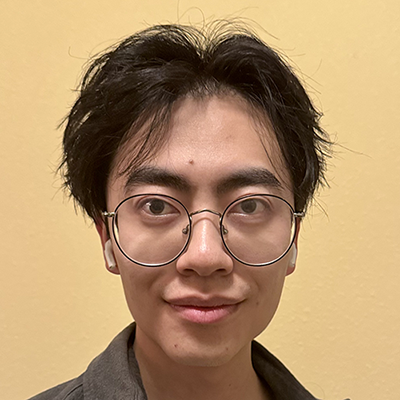 July 1st -- Quantum Technology Master's Student Andre Li has been selected to receive
a prestigious Benzing Award in the amount of $10,000 from the SJSU College of Engineering.
The Dr. Walter C. Benzing Fellowship is intended to support students engaging in research,
with preference given to students who have an interest in pursuing a career in semiconductor-related
fields and to students who have been prior awardees. Andre plans to use the award
to develop cryogenic imaging capabilities in the realm of semiconductor quantum emitters,
working under the guidance of Associate Professor Christopher Smallwood. Congratulations!
July 1st -- Quantum Technology Master's Student Andre Li has been selected to receive
a prestigious Benzing Award in the amount of $10,000 from the SJSU College of Engineering.
The Dr. Walter C. Benzing Fellowship is intended to support students engaging in research,
with preference given to students who have an interest in pursuing a career in semiconductor-related
fields and to students who have been prior awardees. Andre plans to use the award
to develop cryogenic imaging capabilities in the realm of semiconductor quantum emitters,
working under the guidance of Associate Professor Christopher Smallwood. Congratulations!
Retirement Celebration
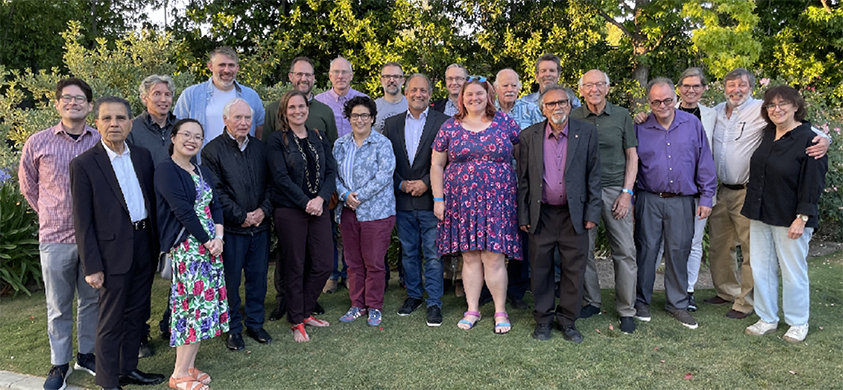
June 19th -- In June the department gathered to celebrate the departures of recent retirements of professors Ranko Heindl, Alej Garcia, Ramen Bahuguna, Monika Kress, and Pat Hamill. The party featured a trivia contest about our honorees, a contest that was won by the all-star team of Michael Kaufman, Pat Hamill , Alej Garcia, Olenka Hubickyj, and Kassa Betre. In a trivia contest where every answer was one of the five honorees, was it fair that the winning team had 40% of the honorees on it? This is a legitimate question. Regardless, congrats to the team. Shortly after our retirement party we learned of one more retirement from the department: William Seneshen, who joined SJSU in 2017. Prior to joining the Department, he spend 13 years at DreamWorks Animation as A VFX Animator and Character FX Supervisor. He leveraged his background in computer graphics software development, animation and visual effects to teach Physics 23 (Animation Physics) and also taught Physics 2A for several semesters.
Quantum Gravity in Duluth
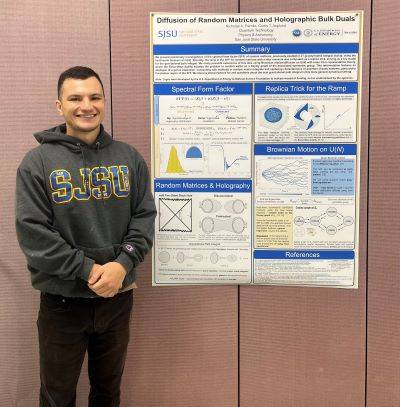 June 9th -- Nicholas Parrilla, a student in the MS in Quantum Technology program,
presented a poster on his research with Assistant Professor Curtis Asplund at a workshop
entitled "Quantum Gravity in Duluth," which took place in Duluth, Minnesota. They
have been studying mathematical models of quantum black hole evolution.
June 9th -- Nicholas Parrilla, a student in the MS in Quantum Technology program,
presented a poster on his research with Assistant Professor Curtis Asplund at a workshop
entitled "Quantum Gravity in Duluth," which took place in Duluth, Minnesota. They
have been studying mathematical models of quantum black hole evolution.
Michigan State University Disability Workshop
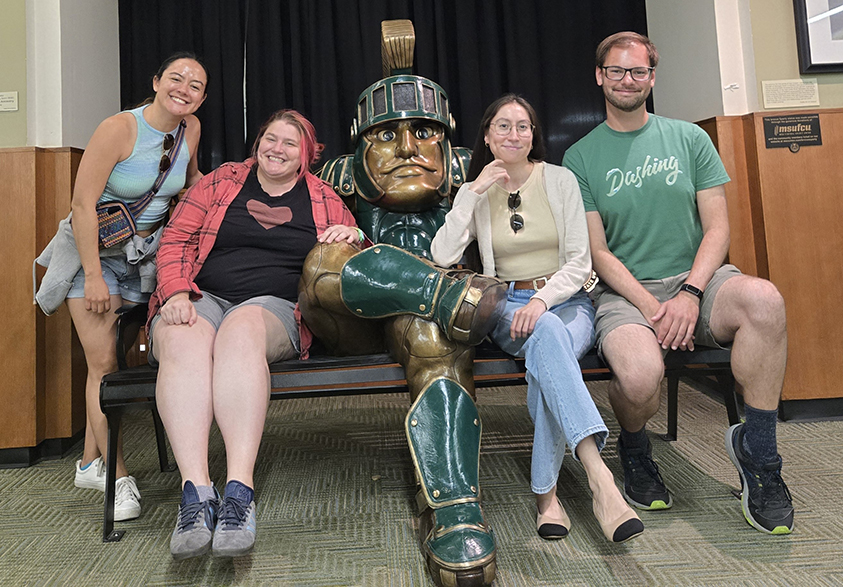
June 6th -- Physics master's student Mariana Rojas-Montoya and Assistant Professor Brianne Gutmann attended a week-long workshop at Michigan State University (where Spartans can go meet other Spartans!) on "Addressing Ableism in Physics through Faculty-Student Partnerships." The workshop provided professional development for students, guidance for instructors on how to improve their curricular materials and practices, and opportunities for feedback and advice within and across groups. The workshop was also highly synergistic with Rojas-Montoya's master’s research, which focuses on the experiences of students with learning disabilities in physics.
Summer Internship at SLAC National Laboratory
June 3rd -- Four SJSU students in the MS in Physics degree program started their summer internship at SLAC National Laboratory, one of top physics laboratories in the world. The students, Brittney Shavor, Muhammad Saeed, Josepf Amador and Alex May, are working with researchers SLAC on projects including building a new kind of plasma particle accelerator, upgrading particle detectors with machine-learning-enhanced microchips, and analyzing gravitational lensing data from the Vera Rubin observatory. This internship is part of the High Energy Physics at SJSU program, which is managed by Assistant Professors Kassa Betre and Curtis Asplund and funded by the US Department of Energy's Office of Science.
Congratulations Graduates!
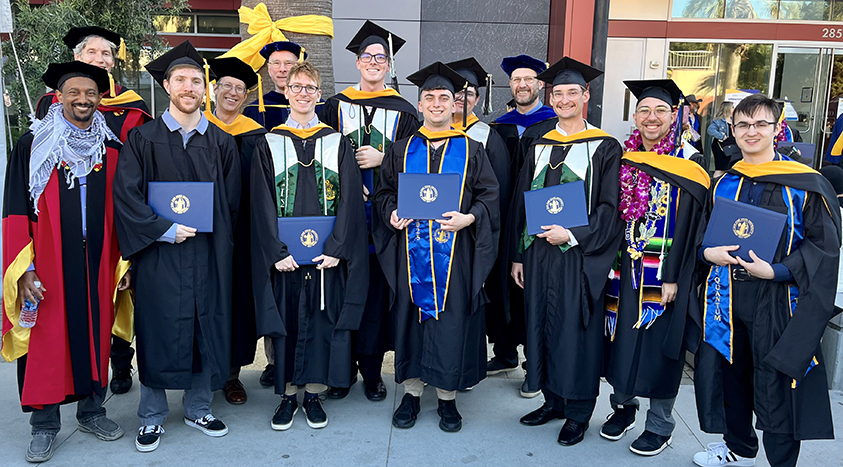
May 22nd -- Congratulations to the Class of 2025. This year's class of graduating undergraudates and master's students includes the first ever cohort of the Department's new MS in Quantum Technology program.
Neil Switz Wins Outstanding Professor Award
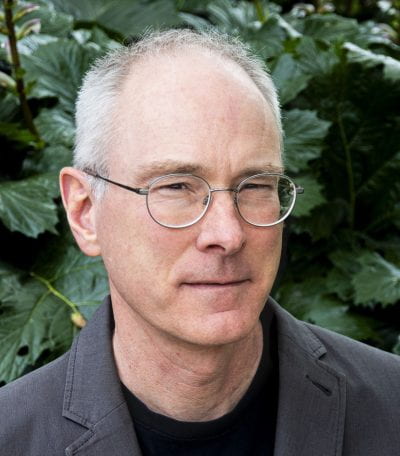 April 16th -- Professor Neil Switz has won the University's Outstanding Professor
Award (see the full list of 2025 Faculty and Staff Awards at the SJSU NewsRoom Blog). Switz, who has been at SJSU since 2016, specializes in
optical imaging, which is considered central to multiple areas of science and technology,
from mobile phone cameras to medical endoscopes to the Hubble Space Telescope. Optical
microscopy remains a primary method of medical diagnosis for many diseases, especially
in remote and/or low-resource areas. The breadth of teaching Switz has undertaken
at SJSU includes electives and core lower- and upper-division theory and lab classes
in physics, as well as a graduate theory class. That experience helps him to connect
concepts for students across their classes, allowing him to preview the work they
will encounter going forward, and how the current material ties in with that work,
creating a more seamless academic experience. Switz owns 18 US patents, many of them
issued since his arrival at SJSU, and he has contributed to the design and deployment
of multiple products and medical devices. This research activity, along with his years
of experience in industry (as director of R&D and founder of a now-public company)
demonstrate his currency in his discipline and provide him with an unusual breadth
of experience which helps him to advise students. Congratulations, Neil!
April 16th -- Professor Neil Switz has won the University's Outstanding Professor
Award (see the full list of 2025 Faculty and Staff Awards at the SJSU NewsRoom Blog). Switz, who has been at SJSU since 2016, specializes in
optical imaging, which is considered central to multiple areas of science and technology,
from mobile phone cameras to medical endoscopes to the Hubble Space Telescope. Optical
microscopy remains a primary method of medical diagnosis for many diseases, especially
in remote and/or low-resource areas. The breadth of teaching Switz has undertaken
at SJSU includes electives and core lower- and upper-division theory and lab classes
in physics, as well as a graduate theory class. That experience helps him to connect
concepts for students across their classes, allowing him to preview the work they
will encounter going forward, and how the current material ties in with that work,
creating a more seamless academic experience. Switz owns 18 US patents, many of them
issued since his arrival at SJSU, and he has contributed to the design and deployment
of multiple products and medical devices. This research activity, along with his years
of experience in industry (as director of R&D and founder of a now-public company)
demonstrate his currency in his discipline and provide him with an unusual breadth
of experience which helps him to advise students. Congratulations, Neil!
oSTEM Defies the Laws of Physics
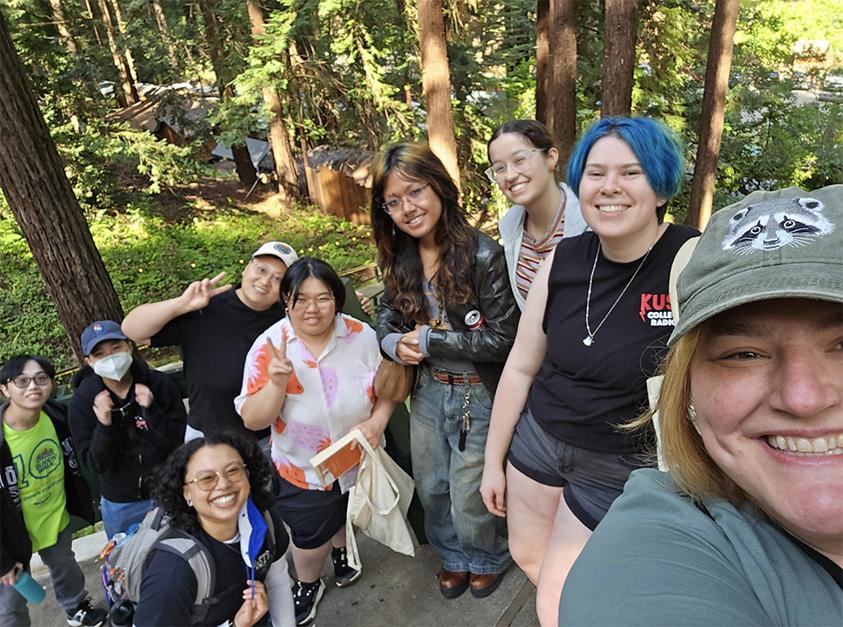
April 15th -- This past weekend, the SJSU chapter of oSTEM (Out in STEM) went on a field trip the Santa Cruz Mystery Spot, where members questioned the laws of physics and heard many theories (including aliens) for why things appeared to be rolling uphill and why people were experiencing length contraction at low speeds. Attendees included undergraduate physics major Marissa Godoy and Assistant Professor Brianne Gutmann.
Accolades in Nuclear Threat Reduction
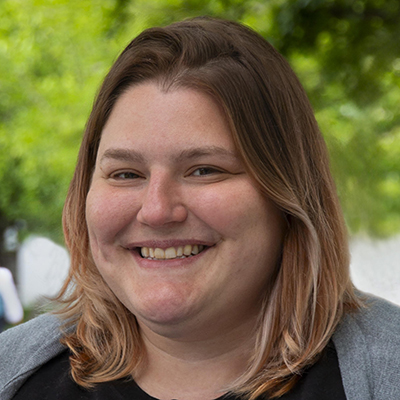 March 15th -- Assistant Professor Brianne Gutmann was selected as a 2025 Next-Generation Fellow by the Physicists Coalition for Nuclear Threat Reduction. The fellowship supports
early career scholars in learning about and advocating to reduce threats from nuclear
weapons. Gutmann’s fellowship is synergistic with ongoing work in collaboration with
Assistant Professor Curtis Asplund, who was a Next-Generation Fellow in 2022.
March 15th -- Assistant Professor Brianne Gutmann was selected as a 2025 Next-Generation Fellow by the Physicists Coalition for Nuclear Threat Reduction. The fellowship supports
early career scholars in learning about and advocating to reduce threats from nuclear
weapons. Gutmann’s fellowship is synergistic with ongoing work in collaboration with
Assistant Professor Curtis Asplund, who was a Next-Generation Fellow in 2022.
AAAS Conference
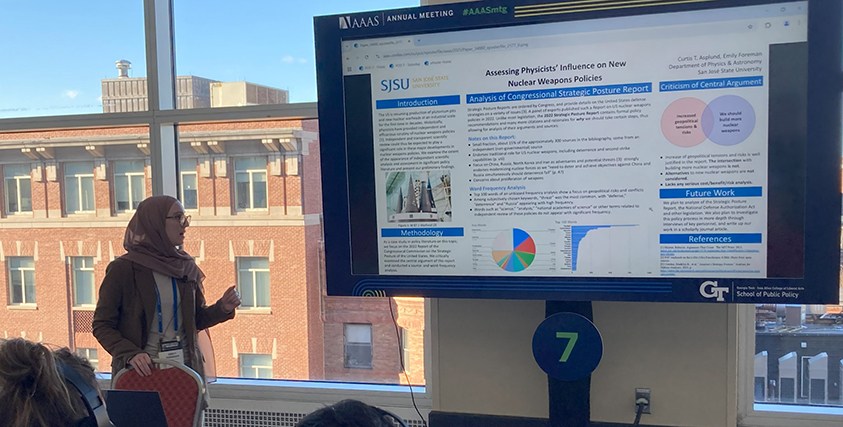
February 14th -- Third year SJSU undergraduate student and physics major Emily Foreman presented research she has been conducting with Assistant Professor Curtis Asplund at the annual conference of the American Association for the Advancement of Science in Boston. The conference convened over 4,000 scientists, scholars, civil servants, policy analysts, journalists and others interested in the intersection of science and public policy. Emily presented research on analyzing the degree and impact of independent scientific review, particularly by physicists, of US nuclear weapons policies. Her poster ended up being awarded a prestigious Honorable Mention by the conference organizers.
Lattice Physics Takes Center Stage
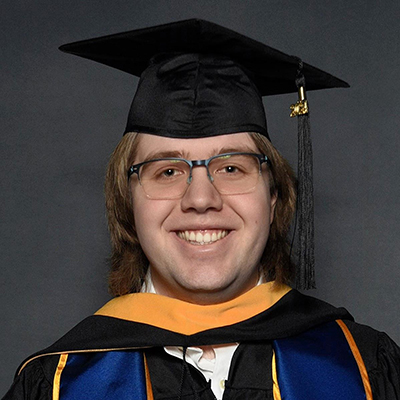 February 11th -- Professor Ehsan Khatami and his former student Robin Newby (MS in
Physics, 2024) have a paper out on an unusual ferromagnetic behavior in a system of
electrons in a two-dimensional atomic crystal. In their numerical study, they show
that in the limit of extreme Coulomb repulsion between electrons that are occupying
every vertex of a square lattice, a magnetic transition happens as soon as some of
them are kicked out of the system. Namely, their spins, which are usually anti-aligned
on neighboring sites (in the so-called anti-ferromagnetic state) tend to line up with
each other and form a ferromagnet (at least on small scales). Intuitively, this can
be understood from the fact that removing some of the electrons allows others to move
around and their motion, which lower the overall energy of the system in the model,
is facilitated by a ferromagnetic background. They find that this "kinetic ferromagnetism"
persists even at relatively high temperatures.
February 11th -- Professor Ehsan Khatami and his former student Robin Newby (MS in
Physics, 2024) have a paper out on an unusual ferromagnetic behavior in a system of
electrons in a two-dimensional atomic crystal. In their numerical study, they show
that in the limit of extreme Coulomb repulsion between electrons that are occupying
every vertex of a square lattice, a magnetic transition happens as soon as some of
them are kicked out of the system. Namely, their spins, which are usually anti-aligned
on neighboring sites (in the so-called anti-ferromagnetic state) tend to line up with
each other and form a ferromagnet (at least on small scales). Intuitively, this can
be understood from the fact that removing some of the electrons allows others to move
around and their motion, which lower the overall energy of the system in the model,
is facilitated by a ferromagnetic background. They find that this "kinetic ferromagnetism"
persists even at relatively high temperatures.
The group also boasts the publication of another paper in Physical Review Research on the use of a recurrent neural network to represent the quantum mechanical wavefunction of many electrons. The former postdoc in the group, Eduardo Ibarra Garcia Padilla, who has recently accepted an offer to be an Assistant Professor of physics at Harvey Mudd College, is the lead author on this work. Congratulations Eduardo!!
Cal-Bridge Mentor Spotlight
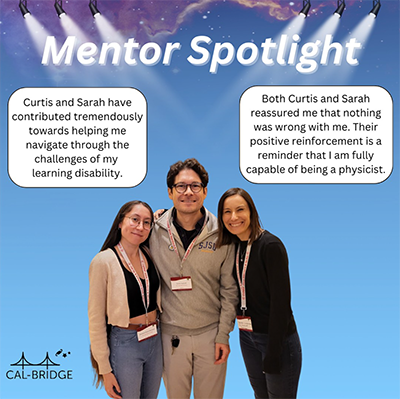 January 30th -- SJSU student Mariana Rojas-Montoya, who is in our MS in Physics program
and is a Cal-Bridge scholar, and her Cal-Bridge mentors, SJSU Professor Curtis Asplund
and UC Merced Professor Sarah Loebman, were featured by the Cal-Bridge program in
their January "Mentor Spotlight." Mariana shared the following about her Cal-Bridge
mentors (pictured center and right), "They are what every mentor should be: compassionate
and encouraging." The Cal-Bridge program is a statewide network of all three segments of the California higher education system—CSU,
UC, and community colleges—together forming a comprehensive, end-to-end pathway for
the diverse undergraduates of California to successfully matriculate to PhD programs,
achieve their PhD, and then join the STEM professoriate in California and nationally
or become leaders in the California science and technology workforce.
January 30th -- SJSU student Mariana Rojas-Montoya, who is in our MS in Physics program
and is a Cal-Bridge scholar, and her Cal-Bridge mentors, SJSU Professor Curtis Asplund
and UC Merced Professor Sarah Loebman, were featured by the Cal-Bridge program in
their January "Mentor Spotlight." Mariana shared the following about her Cal-Bridge
mentors (pictured center and right), "They are what every mentor should be: compassionate
and encouraging." The Cal-Bridge program is a statewide network of all three segments of the California higher education system—CSU,
UC, and community colleges—together forming a comprehensive, end-to-end pathway for
the diverse undergraduates of California to successfully matriculate to PhD programs,
achieve their PhD, and then join the STEM professoriate in California and nationally
or become leaders in the California science and technology workforce.
CU*iP 2025
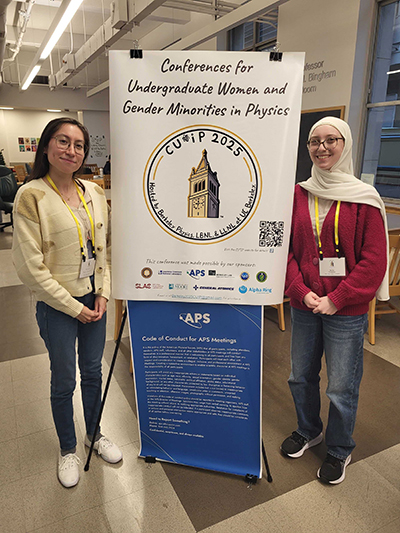 January 27th -- SJSU students Mariana Rojas-Montoya and Emily Foreman attended a Conference
for Undergraduate Women and Gender Minorities in Physics (CU*iP) this past weekend
(January 24-26) at UC Berkeley. CU*iP events aim to give students often who do not
see themselves represented in physics the opportunity to network and explore both
career and educational pathways. Foreman spent the weekend networking with other conference
attendees, and got the opportunity to tour Lawrence Berkeley National Laboratory (LBNL).
Rojas-Montoya spent her time as a volunteer working alongside Berkeley students and
LBNL volunteers.
January 27th -- SJSU students Mariana Rojas-Montoya and Emily Foreman attended a Conference
for Undergraduate Women and Gender Minorities in Physics (CU*iP) this past weekend
(January 24-26) at UC Berkeley. CU*iP events aim to give students often who do not
see themselves represented in physics the opportunity to network and explore both
career and educational pathways. Foreman spent the weekend networking with other conference
attendees, and got the opportunity to tour Lawrence Berkeley National Laboratory (LBNL).
Rojas-Montoya spent her time as a volunteer working alongside Berkeley students and
LBNL volunteers.
A Fond Farewell to Alejandro Garcia
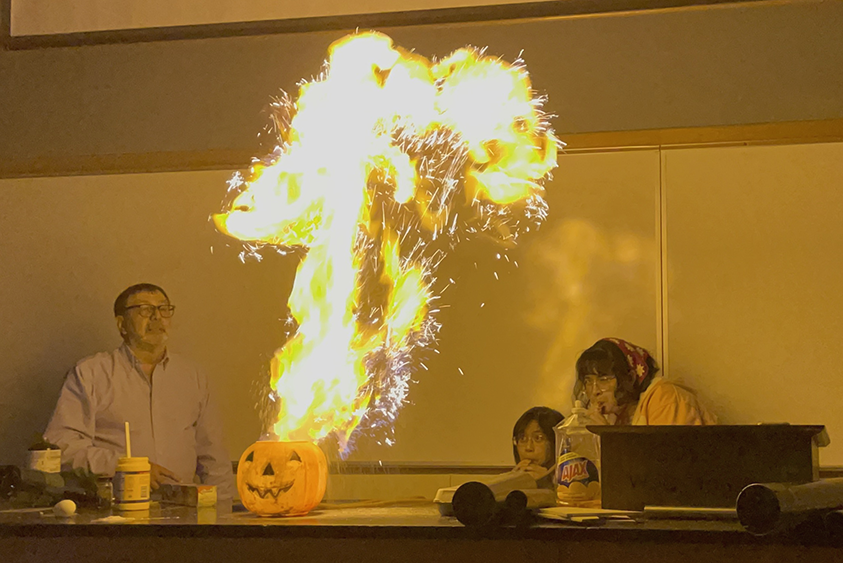
January 24th -- Hundreds of students, faculty members, and friends met up at WSQ 109 to wish Professor Alejandro Garcia farewell as he transitions into retirement, and to watch him perform some of the greatest hits of the many demos he has worked with and helped to develop over the years. He will be sorely missed! The event was hosted by Professor David Chai of the Animation & Illustration Design Program, where Garcia has built up strong connections over the years. Carlos Morante helped assemble demos.
Cosmic Dust Shells
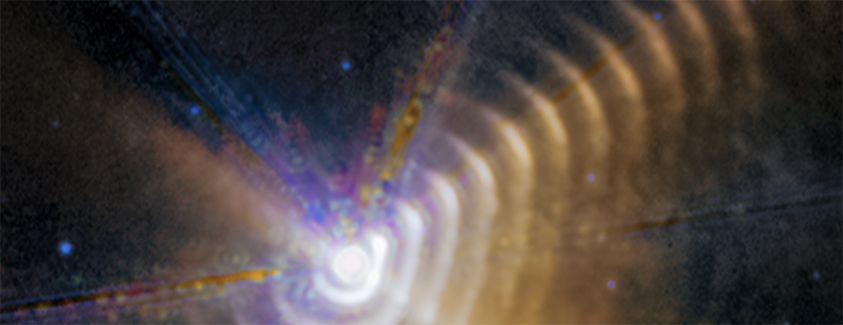
January 23rd -- Associate Professor Thomas Madura and collaborators have a new paper out using the James Webb Space Telescope to identify two stars responsible for generating carbon-rich dust a mere 5,000 light-years away in our own Milky Way galaxy. As the massive stars in Wolf-Rayet 140 swing past one another on their elongated orbits, their winds collide and produce carbon-rich dust. For a few months every eight years, the stars form a new shell of dust that expands outward — and may eventually go on to become part of stars that form elsewhere in our galaxy. The findings have been published in The Astrophysical Journal Letters, and the Space Telescope Science Institute has also written up a popular summary.
New Insights into the Benefits of Reformed Physics Courses
 January 23rd -- Professor Cassandra Paul and her colleague David Webb at UC Davis
have a paper out uncovering new benefits of implementing "reformed" physics courses
(courses incorporating high levels of active learning strategies in their design structure)
at the introductory college level. The paper is entitled "Examining equity and graduation
rates at two institutions using a course deficit model and the collaborative learning
through active sense-making in physics curriculum," and it was published on January
23rd in the journal Physical Review Physics Education Research.
January 23rd -- Professor Cassandra Paul and her colleague David Webb at UC Davis
have a paper out uncovering new benefits of implementing "reformed" physics courses
(courses incorporating high levels of active learning strategies in their design structure)
at the introductory college level. The paper is entitled "Examining equity and graduation
rates at two institutions using a course deficit model and the collaborative learning
through active sense-making in physics curriculum," and it was published on January
23rd in the journal Physical Review Physics Education Research.
As universities are currently struggling with how to retain students, decrease equity gaps, and increase graduation rates in a post-pandemic world, Paul and Webb compare the original success of a radically reformed introductory physics course with an implementation at a second institution. They find that students who take this reformed course at both institutions are 1) less likely to drop, 2) less likely to fail, and 3) do as well in later coursework when compared to students who took the original courses. The above items are found to be independently true for historically marginalized students. Furthermore, they find that 4) marginalized students who take this course 6% are more likely to graduate from a STEM field, eliminating the graduation equity gap at one institution. Building from their prior work, they continue to claim that demographic group differences are, perhaps, better understood as a problem with the system (i.e., through the lens of a "course deficit model") rather than as a problem with the demographic groups. Using this approach can be useful when determining how to eliminate student achievement gaps. Paul and Webb argue that higher education has the tools needed to significantly increase equity, and improve student success and retention in STEM. This requires an investment in the reform of large introductory STEM courses.
Ehsan Khatami Wins $628k from the NSF for High-Performance Computing
 January 22nd -- Professor Ehsan Khatami has been awarded a $628k research infrastructure
grant from the National Science Foundation to fund the installation of an updated
high-performance computing cluster here on campus. The grant, entitled "Research Infrastructure:
CC* Compute-Campus: A campus-wide computing resource for research and teaching at
San Jose State University," was written by Khatami in collaboration with Bob Lim (the
SJSU Vice President of Information Technology and Chief Information Officer) and Feruza
Amirkulova (an assistant professor in the Department of Mechanical Engineering). Congratulations,
Ehsan!
January 22nd -- Professor Ehsan Khatami has been awarded a $628k research infrastructure
grant from the National Science Foundation to fund the installation of an updated
high-performance computing cluster here on campus. The grant, entitled "Research Infrastructure:
CC* Compute-Campus: A campus-wide computing resource for research and teaching at
San Jose State University," was written by Khatami in collaboration with Bob Lim (the
SJSU Vice President of Information Technology and Chief Information Officer) and Feruza
Amirkulova (an assistant professor in the Department of Mechanical Engineering). Congratulations,
Ehsan!
